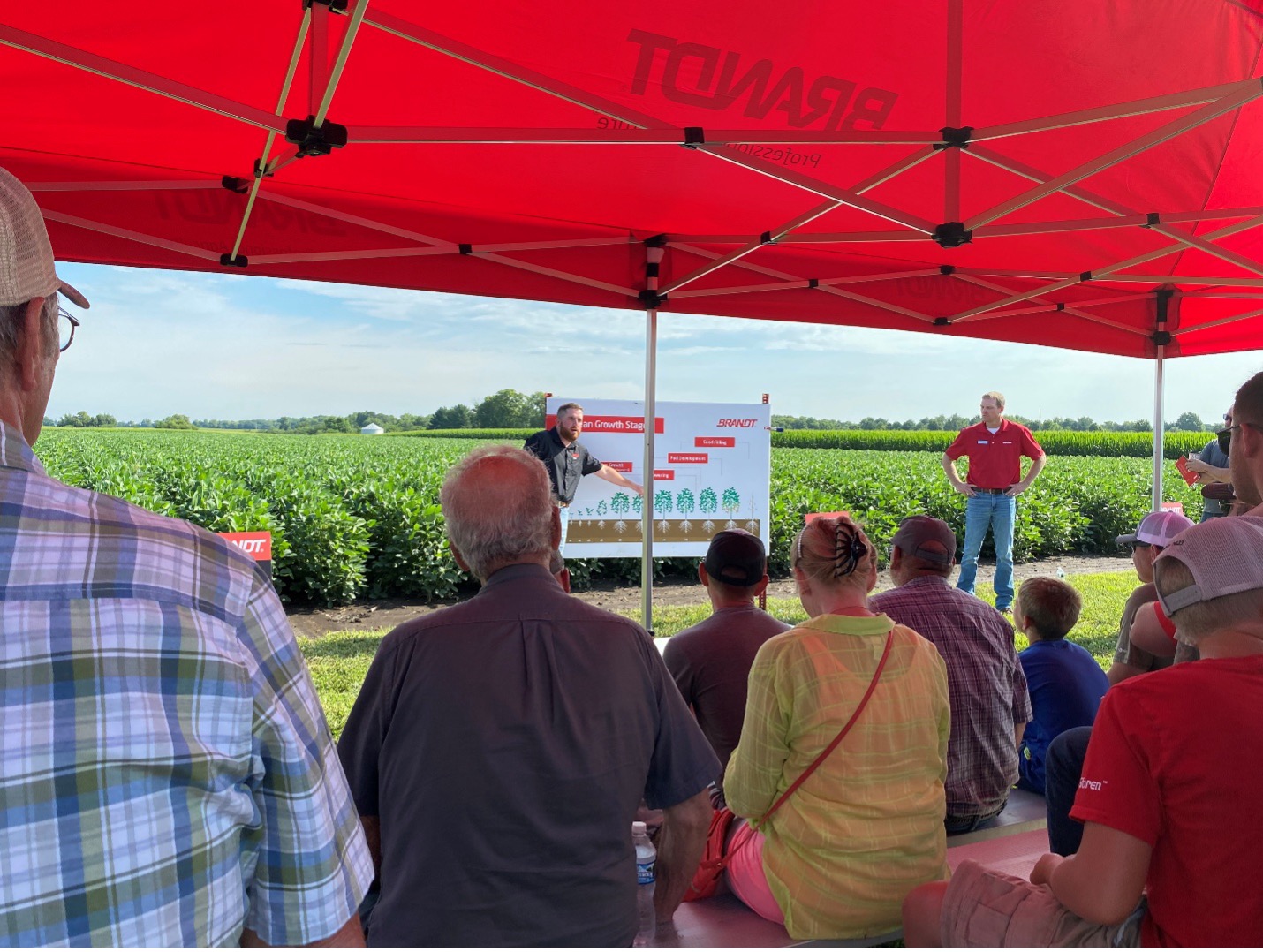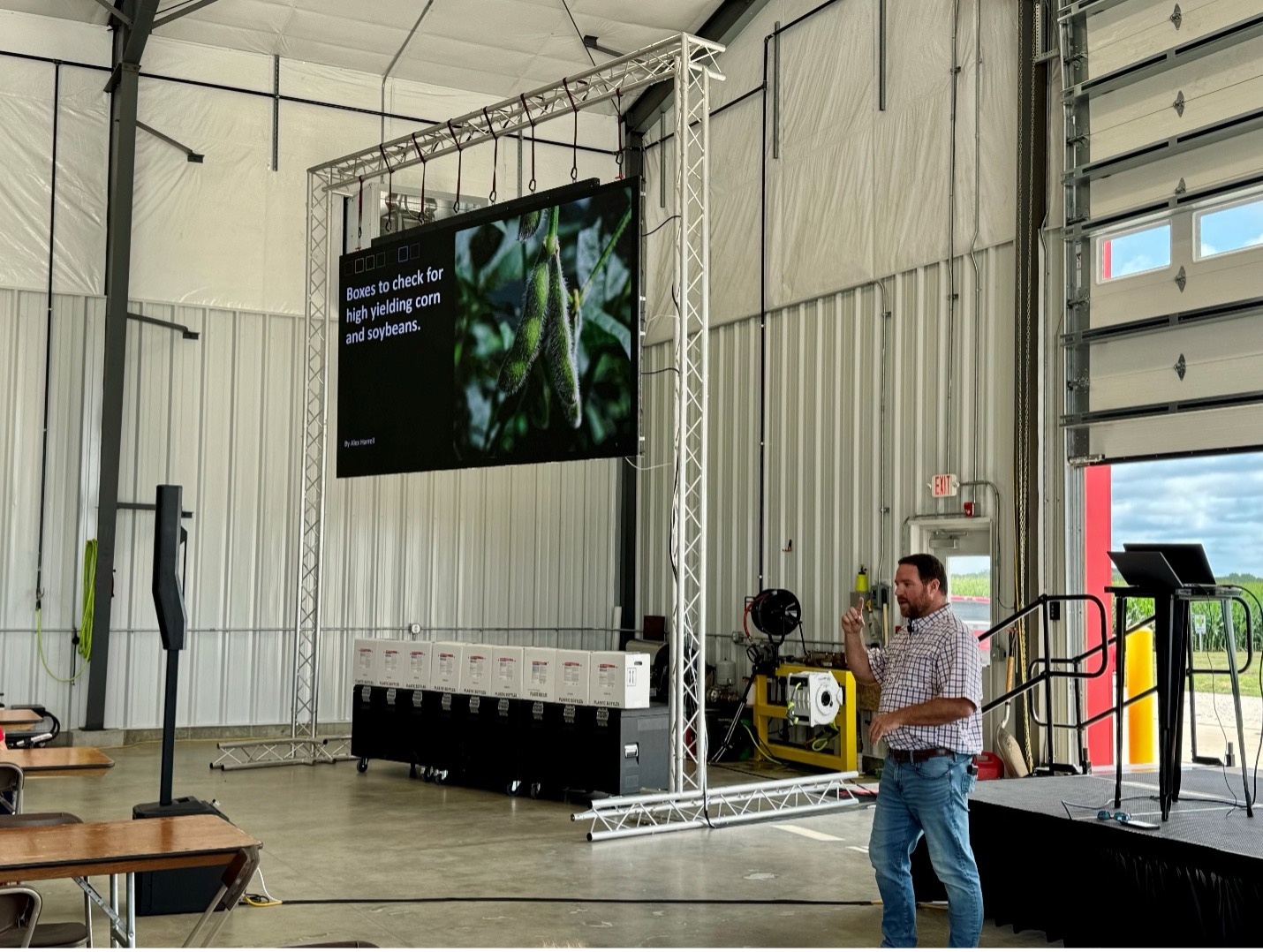With beans flowering and corn tasseling across central Illinois, it's that time of year when farmers start asking: Are we on track for a high-yielding season?
High-yielding corn and soybeans were the key topics at the 2025 BRANDT Agronomy Day, hosted at the Evelyn Brandt Thomas Ag Innovation Center in Pleasant Plains on July 17. World soybean yield record holder Alex Harrell, who grew a 218.3-bushel soybean crop in 2024, surpassing his previous record of 206.8 bushels in 2023, joined BRANDT agronomists Dr. Eric Winans and Dr. Marcos Loman to discuss the science and management practices needed to achieve high-yielding crops.
In Winans's field talk, he reminded us of what makes soybean yield: the number of pods per node, the number of seeds per pod, and the weight of each seed. Usually, management practices implemented from emergence through R4 directly affect seed number, while practices put in place during grain fill (R5 onwards) will impact seed weight. Most farmers consider an R3 fungicide spray their "late-season" application. However, Winans emphasizes that farmers should pay close attention to the crop's nutritional needs after R3 to push higher yields, since 50% of biomass production and nutrient uptake occurs after this stage.
Winans points out that nitrogen (N) can be one of the most limiting nutrients for high soybean yields, as plants require 4 lbs. of N per bushel of grain produced, most of which is allocated to the grain for protein production. Therefore, ensuring the crop has a sufficient N supply during reproductive growth can take yields to the next level. This is especially true after R4, as the plants are actively mobilizing sugars and nutrients to fill the grain. This process limits the flow of photoassimilates to the nodules, leading to nodule senescence and reduced N contribution to the crop.
Although soil N generally accounts for 50% of the N soybeans utilize, when nodules stop assimilating it at the end of the season, the soil supply becomes an essential N source for seed fill. A higher N supply late in the season may drive higher yields by impacting seed weight.
Illinois farmers are not typically making late-season N applications, but some growers, like Harrell, are pushing management to the next level when it comes to high-yield soybeans. Harrell preaches a season-long approach and says that there are six boxes farmers should check to reach their highest soybean yield potential.
The first box is soil sampling and balanced nutrition, with balanced nutrition being a key factor to consider when making application decisions before and throughout the growing season. It is well known that soil nutrient supply varies significantly across a field, and as such, Harrell collects annual soil samples on a one-acre grid on every field. Using this methodology, Harrell and his team discovered previously unknown issues with fertility levels and pH and were able to make corrective applications.
The second box Harrell emphasizes is the planter checklist, as ensuring equipment settings are fine-tuned for the field is vital for setting plants up for success. Harrell treats each row of his planter as a separate planter and adjusts planting depths and discs accordingly. Ultimately, he considers singulation and emergence to be the key factors dictating the performance of the crop for the remainder of the season. Therefore, he decides how much in-season management to invest in based on how uniformly the crop has emerged. If a crop doesn't show high potential after emergence, he will not proceed with intensive management, and will therefore save on costs to maximize return on investment.
This brings us to boxes three, four, and five, which dive into early–, mid-, and late-season management. Harrell mentions his use of many in-season applications, such as in-furrow fertility, plant growth regulators (PGRs), Y-drop, drone applications, fungicides, and more. To determine in-season fertility applications, Harrell tissue samples his beans every week, and proceeds with an application if the tests show a consistent nutrient deficiency three weeks in a row. This reinforces the underlying principle of maintaining balanced nutrition, as a single nutrient may be limiting your yield, but this can be corrected with proper monitoring.
Photo demonstrating the increase in pods per node at the top of the plant after correcting nutrient imbalances with a nutrient and PGR application.
The last box to check for achieving high yield is harvest. To avoid header loss and pod shattering, it is crucial to harvest your beans before they become too dry, especially before they regain moisture from rain or snow and dry again. Cycles of gaining moisture and re-drying will increase the amount of shattering and cracking, so try to avoid these situations if possible.
It's important to remember that high-management strategies aren't cost-effective on every field, and not all fields have the potential to produce a 218-bushel soybean yield. The practices Harrell employs are calculated and tailored to each field's potential for the given season. His high yields simply showcase the genetic potential of soybean plants when supported by precise monitoring and advanced management practices and can inspire growers to explore what's possible on their highest-potential fields.





 and then
and then